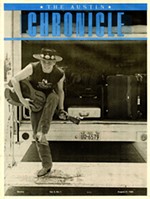Spreading Mono
By Lee Nichols, Fri., April 12, 2002
When most people think of monorail, no doubt "that thing at Disney World?" springs to mind. Monorail, however, isn't confined to fantasyland, but is already in limited use in some cities. AMP's Web site, www.austinmonorail.com, makes arguments for monorail, with position papers on why it provides superior, safer transit and a blow-by-blow refutation of the rating system Capitol Metro's Rapid Transit Project used last year in its "Milestones" report (see www.rapidtransitproject.org) to back light rail over other modes. The AMP site even includes a detailed map of a proposed monorail route, and animated video clips of what monorail in Austin would look like.
The source of inspiration for Duty's crusade was a trip he took on Seattle's monorail system. After working on South Congress and listening to business people talk about the threats light rail would pose to their businesses, "I went to Seattle and it clicked," he says. He admits monorail faces an uphill fight in Austin. The Web site expresses frustration over Cap Metro's unwavering dedication to the light rail concept, calling the agency's rating system "highly biased and flawed," and accusing it of trying to "deliberately confuse" citizens into supporting light rail.
"That's an opinion they have, but we feel pretty confident that we used the right rating system," responds Rapid Transit Project director John Almond. "I've seen the Web site, and I think it's great that others are promoting mass transit, [but] with respect to monorail, there aren't many publicly funded monorail projects in the U.S." Most monorails, he says, are privately operated. "We've said all along that as a public agency using tax money, we didn't want to be a guinea pig."
Almond says most monorail technology is proprietary rather than standardized. One manufacturer's supplies won't necessarily fit another's, limiting Cap Metro's options in vendors. Yet Duty maintains that the biggest hurdle is explaining monorail to the public. "The problem is that people think we're promoting light rail," he said. "They don't understand that it is a different concept."
Got something to say on the subject? Send a letter to the editor.








